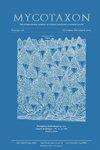来自中国广东的印度Zasmidium sinense sp.nov
IF 0.4
4区 生物学
Q4 MYCOLOGY
引用次数: 0
摘要
本文描述和说明了采自中国广东省一种身份不明的阔叶树的枯枝上的Zasmidium sinense。新种的特征是分化的分生孢子具有分枝的头状花序,分生细胞具有多胚芽、合聚、明显愈合的分生细胞,产生单生的、倒卵形的或棒状的、浅棕色的、光滑的1(-2)‐深裂的分生孢子。本文章由计算机程序翻译,如有差异,请以英文原文为准。
Zasmidium sinense sp. nov. from Guangdong, China
Zasmidium sinense , collected from dead branches of an unidentified broadleaf tree in Guangdong Province, China, is described and illustrated. The new species is characterized by differentiated conidiophores having a branched head with polyblastic, sympodial, conspicuously cicatrized
conidiogenous cells that produce solitary, obovoid to clavate, pale brown, smooth, 1(–2)‐euseptate conidia.
求助全文
通过发布文献求助,成功后即可免费获取论文全文。
去求助
来源期刊

Mycotaxon
生物-真菌学
CiteScore
1.20
自引率
10.00%
发文量
53
审稿时长
3 months
期刊介绍:
Mycotaxon is a quarterly peer-reviewed journal exclusively devoted to all phases of the taxonomy and nomenclature of fungi (including lichens). All articles are peer-reviewed by specialists prior to acceptance. Publication is open to all persons. Authors prepare their own article after having received critical comments from pre-submission reviewers .The journal is published with one volume each quarter. Articles are accepted in English only, with summaries or abstract in any language(s).
 求助内容:
求助内容: 应助结果提醒方式:
应助结果提醒方式:


